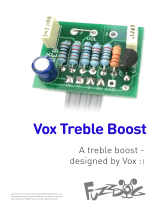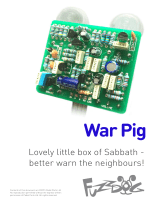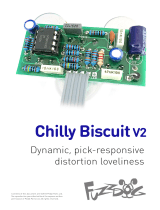Page is loading ...

Figaro Drive
A box of of Brian May’s
Treble Boost + AC30 Tone
Contents of this document are ©2015 Pedal Parts Ltd.
No reproduction permitted without the express written
permission of Pedal Parts Ltd. All rights reserved.

Schematic + BOM
R1 220K
R2 68K
R3 10K
R4 8K2
R5 100K
R6 470K
R7 680K
R8 1M
R9 1M
R10 1K
R11 1K
R12 56K
R13 470K
R14 1K
R15 1K
R16 1M
R17 1M
R18 10K
R19 100K
R20 62K
R21 12K
R22 1K
R23 2M2
R24 2M2
R25 4K7
R26 8K2
R27 1M*
R28 2K2 (CLR)
Q1-5 MPF4393
Q7** P2N2222A
D1 1N4001
TONE 1MA
VOL 250KB
GAIN 5KC
C1 4n7
C2 47p
C3 10n
C4 100n
C5 100n
C6 470p
C7 220n
C8 47p
C9 22n
C10 22n
C11 1n
C12 680n
C13 47u elec
C14 2u2 elec
C15 22u elec
C16 1u elec
C17 2u2 elec
C18 47u elec
*Optional anti-pop resistor not in original circuit.
**See note overleaf regarding different types of 2N2222A for Q7.

The power and signal pads on the PCB
conform to the FuzzDog Direct
Connection format, so can be paired with
the appropriate daughterboard for quick
and easy offboard wiring.
Be very careful when soldering the diode
and transistors. They’re very sensitive to
heat. You should use some kind of heat
sink (crocodile clip or reverse action
tweezers) on each leg as you solder them.
Keep exposure to heat to a minimum
(under 2 seconds). Best to use a socket
for the chip.
The striped leg (cathode) of the diode
goes into the square pad.
The long leg (anode) of the electrolytic
capacitors go into the square pads.
There’s room to lay C18 flat across the top of R28. This will give you plenty of clearance in the enclosure.
Snap the small metal tag off the pots so they can be mounted flush in the box.
Pots mount on the back side of the board. You can use vertical-mount pots or just wire up ‘normal’ ones.
Ensure you get them all at the same height, and if there are no plastic covers on them make sure you have
plenty of clearance between the pot body and the solder side of the PCB, otherwise you’ll short out
components. Best way to do this is get some thick cardboard and put it between the pots and the board
when soldering. Remove it once they’re in place.
To get them all the same height its best to solder a single pin of each so you have all three pots in place.
See if they all line up ok. If not, simply melt the connection of any that aren’t right and adjust. Much easier
than trying to do it if all three pints are
soldered. Once they’re aligned, solder the
other two pins of each pot.
Favourite technique at FDHQ is to put the
pots into the holes on the top side of the
enclosure to get everything lined up nicely
while soldering.
Q7 CONFUSION
Usefully, different manufacturers use
different pinouts for their versions of
2N2222A. We will supply one of two kinds -
you should check which you have before
placing Q7.
P2N2222A - this should be inserted as
shown on the PCB silkscreen, flat side
towards C1.
PN2222A - this should be reversed - flat
side towards C12.
PCB Layout ©2015 Pedal Parts Ltd.

Test the board!
UNDER NO CIRCUMSTANCES will troubleshooting help
be offered if you have skipped this stage. No exceptions.
Once you’ve finished the circuit it makes sense to test is before starting on
the switch and LED wiring. It’ll cut down troubleshooting time in the long
run. If the circuit works at this stage, but it doesn’t once you wire up the
switch - guess what? You’ve probably made a mistake with the switch.
Solder some nice, long lengths of wire to the board connections for 9V, GND,
IN and OUT. Connect IN and OUT to the jacks as shown. Connect all the
GNDs together (twist them up and add a small amount of solder to tack it).
Connect the battery + lead to the 9V wire, same method. Plug in. Go!
If it works, crack on and do your switch wiring. If not... aw man.
At least you know the problem is with the circuit. Find out why, get it
working, THEN worry about the switch etc.
BATTERY
IN OUT
Your nice, new circuit board
INCLUDING WIRED POTS!!!!
IN 9V GND OUT

(if using a daughterboard please refer to the relevant document)
Wire it up - DC only version
This circuit is standard, Negative GND. Your power supply should be
Tip Negative / Sleeve Positive. That’s the same as your standard pedals
(Boss etc), and you can safely daisy-chain your supply to this pedal.
The BOARD GND connections don’t all have to connect to one point.
They can be daisy-chained around the circuit, using larger connection
points (such as jack socket lugs) for multiple connections. As long as
they all connect together in some way.
L
E
D
BOARD
OUT
BOARD
9V
BOARD
GND
BOARD
GND
BOARD
GND
BOARD
INPUT
+
IN
OUT
L
E
D
BOARD
GND
BOARD
LED+

(if using a daughterboard please refer to the relevant document)
Wire it up - with battery
This circuit is standard, Negative GND. Your power supply should be
Tip Negative / Sleeve Positive. That’s the same as your standard pedals
(Boss etc), and you can safely daisy-chain your supply to this pedal.
The BOARD GND connections don’t all have to connect to one point.
They can be daisy-chained around the circuit, using larger connection
points (such as jack socket lugs) for multiple connections. As long as
they all connect together in some way.
PedalParts.co.uk
L
E
D
BOARD
OUT
BOARD
9V
BOARD
GND
BOARD
GND
BOARD
GND
BOARD
INPUT
BATTERY
+
IN
OUT
L
E
D
BOARD
GND
BOARD
LED+
+
Just because the
FuzzDog enclosure
won’t take a battery,
there’s nothing
stopping you using a
bigger box.

Drilling template
Hammond 1590B
60 x 111 x 31mm
Figaro Drive
Recommended drill sizes:
Pots 7mm
Jacks 10mm
Footswitch 12mm
DC Socket 12mm
This template is a rough guide only. You should ensure correct marking of your
enclosure before drilling. You use this template at your own risk.
Pedal Parts Ltd can accept no responsibility for incorrect drilling of enclosures.
PedalParts.co.uk
32mm
22mm
It’s a good idea to drill
the holes for the pots
8mm to give yourself
some wiggle room
unless you’re a drill ninja
/










